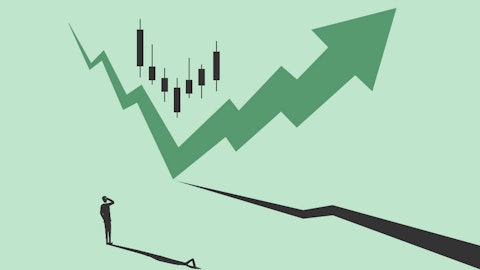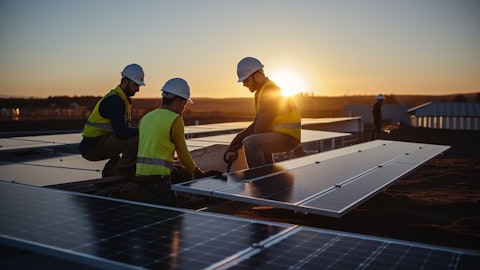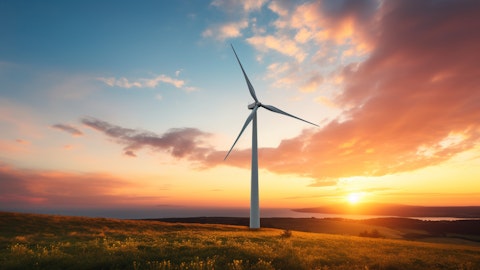Rebecca Kujawa : Good morning, Steve. It’s Rebecca. First on the data centers, clearly there’s an enormous amount of demand being driven across the U.S. economy by the growth in data centers, driven by a lot of things, of course, but specifically, generative AI, and that growth is pretty explosive at this point. And I think the characteristics of that demand are a little bit unique in driving different ways in approaching the marketplace for a number of these technology companies where it is imperative that these projects get built on time, on budget, and produce the energy that they’re expecting because the opportunity cost for these customers is so significant if they aren’t able to power them and, of course, meet the commitments that they’ve made to their own stakeholders.
So we’re seeing those relationships expand and also deepen, where it’s not just signing the megawatts of the day, but also working with them collaboratively over a long period of time to ensure that they get the energy and capacity that they need where they needed to support their projects. Just alone in our backlog, not even counting what we have installed, we have over three gigawatts of projects that we’re building in the coming years for these customers. And I do believe that’s the tip of the iceberg. And again, not even talking about what we already have installed. So it’s pretty exciting. And our team is very ingrained in working with these customers. And we’re excited about the years ahead. And then turning to hydrogen, obviously the guidance that first came out, the draft guidance in December, is really steering towards hydrogen projects that will be essentially from day one, needing to match on an hourly basis.
And that, of course, increases the ultimate cost of hydrogen. And unfortunately, I think if it stands as currently drafted, would limit to an extent how much will be built for the U.S. market. We’re obviously advocating more of a relaxed matching requirements of more of an annual match for a period of time and then transitioning to hourly over time so that you can kick start a hydrogen market. And hopefully the administration will hear that and know that having a kick started hydrogen economy will certainly further their ambitious goals, which of course we are very excited about meeting to see the full decarbonization of the U.S. economy over time. So more work to be done and we are excited to pursue the marketplace. Regardless, these are probably end of the decade type projects, so more of an investment in the near term for opportunities in the long term.
Operator: The next question comes from David Arcaro of Morgan Stanley.
David Arcaro: Hey, good morning. Thanks so much for taking my question. Maybe on the renewables demand side of things, could you give a little bit more detail on the origination trends that you’re seeing? I guess it looked like solar and storage quite strong in the quarter, but then wind a little bit lower in terms of the new bookings added. Maybe what’s your latest confidence in achieving those ‘25 and ‘26 targets, particularly on the wind side of the business?
Rebecca Kujawa : Hey, David. It’s Rebecca. I’ll take a first cut at that. We’re obviously excited about the origination, as John and Kirk have highlighted, originating 17 gigawatts over the last two years, and both years serving as a record, so this year topping last year’s record is very exciting. We also, of course, see the mix being more focused towards solar and storage, and as I’ve commented in the past, I think some of this is an after effect of the strong demand that we saw going into 2020 when we and others thought that the production tax credit would ultimately phase down and then ultimately go to zero over a period of time, so there was a pull forward of demand. And then the second dynamic that I think has impacted the short term is that the solar production tax credit clearly stimulated near-term demand and deployments for our customers, and obviously we’re very excited about that.
Storage is growing at least as well as we thought, perhaps exceeding even our expectations in terms of adoption, not just in the Western markets, but now really spreading in a very constructive way through the Midwest, and we’ve got, as John highlighted in the prepared remarks, a really advantaged position to be able to respond quickly to the demand characteristics that we’re seeing where our customers need capacity quickly, where they hadn’t anticipated the demand that they would see in their underlying business. And so getting to market quickly is very much a premium and a priority, and we’re there to serve them well. In that storage market, as we’ve talked about from a returns characteristic standpoint, it’s an awful lot like wind, and it’s certainly complex to deliver the value that our customers are looking for in the various streams.
I’d say the other part that is at least as strong as we anticipated when we laid out the expectations is repowering. And we’re excited about the economics of that and economics specifically in context to the value that it brings to our customers, bringing some incremental generation and extending the life of these projects, often extending the contracts with our customers at the same times that we do repowering. So overall, with all those comments in context, I feel really good about meeting our development expectations in aggregate. We’ll continue to look at the mix in individual technologies over time. But at this point, we are obviously leaving the ranges as we’ve had them now for a couple of years, in part to reflect what I’m sure you recall, wind is a very short development cycle.
Maybe not the actual laying the groundwork to be able to build a project, but when we enter into a contract and acquire the term and put it into service, it can be as short as nine months. So there’s still a lot of time left between now and the end of ‘26 to add more wind to not only the backlog, but ultimately commission. And when I look at the forward couple of quarters, there are a couple of chunky opportunities that our teams are working on, and I feel good about bringing them some of those to fruition.





